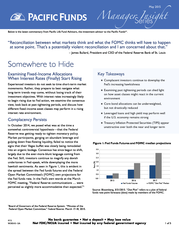Description
January 2015
The MSCI World Index is a free float-adjusted market capitalization weighted index that is designed to measure the
equity market performance of developed markets. The MSCI World Index consists of the following 23 developed market
country indexes: Australia, Austria, Belgium, Canada, Denmark, Finland, France, Germany, Hong Kong, Ireland, Israel, Italy,
Japan, Netherlands, New Zealand, Norway, Portugal, Singapore, Spain, Sweden, Switzerland, the United Kingdom, and the
United States.
The Consumer Price Index (CPI) is a measure of the average change over time in the prices paid by consumers for a
market basket of consumer goods and services as determined by the U.S. Bureau of Labor Statistics.
Treasury Inflation Protected Securities (TIPS) are treasury securities that are indexed to inflation in order to protect
investors from the negative effects of inflation.
About Pacific Life Fund Advisors
Established in 2007, Pacific Life Fund Advisors LLC (PLFA) provides multi-asset and balanced allocation solutions through its
asset allocation, manager research, and investment risk management functionalities. PLFA is an SEC-registered investment
adviser and a wholly owned subsidiary of Pacific Life Insurance Company (Pacific Life).
As of December 31, 2014, PLFA managed approximately $43 billion in total assets. A publication provided by Pacific Funds. These views represent the opinions of Pacific Life Fund Advisors and are presented for informational purposes only. These views should not be construed as investment advice, the offer or sale of any investment, or to predict performance of any investment.
All material is compiled from sources believed to be reliable, but accuracy cannot be guaranteed. The opinions expressed herein are based on current market conditions, are as of December 2014, and are subject to change without notice. All investing involves risk, including the possible loss of the principal amount invested. You should carefully consider an investment’s goals, risks, charges, strategies, and expenses. This and other information about Pacific Funds are in the prospectus available from your financial advisor or by calling (800) 722-2333, option 2. Read the prospectus carefully before investing. Pacific Life Fund Advisors LLC (PLFA), a wholly owned subsidiary of Pacific Life Insurance Company, is the investment advisor to the Pacific Funds (PF) and the manager of certain PF funds.
PLFA also does business under the name Pacific Asset Management and manages certain PF funds under that name. Mutual funds are offered by Pacific Funds and are distributed by Pacific Select Distributors, LLC (member FINRA & SIPC), a subsidiary of Pacific Life Insurance Company (Newport Beach, CA), and are available through licensed third-party broker/dealers. W30528-15A 4 of 4 Mailing address: P.O. Box 9768, Providence, RI 02940-9768 (800) 722-2333, Option 2 • www.PacificFunds.com 4 of 4 .
As of December 31, 2014, PLFA managed approximately $43 billion in total assets. A publication provided by Pacific Funds. These views represent the opinions of Pacific Life Fund Advisors and are presented for informational purposes only. These views should not be construed as investment advice, the offer or sale of any investment, or to predict performance of any investment.
All material is compiled from sources believed to be reliable, but accuracy cannot be guaranteed. The opinions expressed herein are based on current market conditions, are as of December 2014, and are subject to change without notice. All investing involves risk, including the possible loss of the principal amount invested. You should carefully consider an investment’s goals, risks, charges, strategies, and expenses. This and other information about Pacific Funds are in the prospectus available from your financial advisor or by calling (800) 722-2333, option 2. Read the prospectus carefully before investing. Pacific Life Fund Advisors LLC (PLFA), a wholly owned subsidiary of Pacific Life Insurance Company, is the investment advisor to the Pacific Funds (PF) and the manager of certain PF funds.
PLFA also does business under the name Pacific Asset Management and manages certain PF funds under that name. Mutual funds are offered by Pacific Funds and are distributed by Pacific Select Distributors, LLC (member FINRA & SIPC), a subsidiary of Pacific Life Insurance Company (Newport Beach, CA), and are available through licensed third-party broker/dealers. W30528-15A 4 of 4 Mailing address: P.O. Box 9768, Providence, RI 02940-9768 (800) 722-2333, Option 2 • www.PacificFunds.com 4 of 4 .









